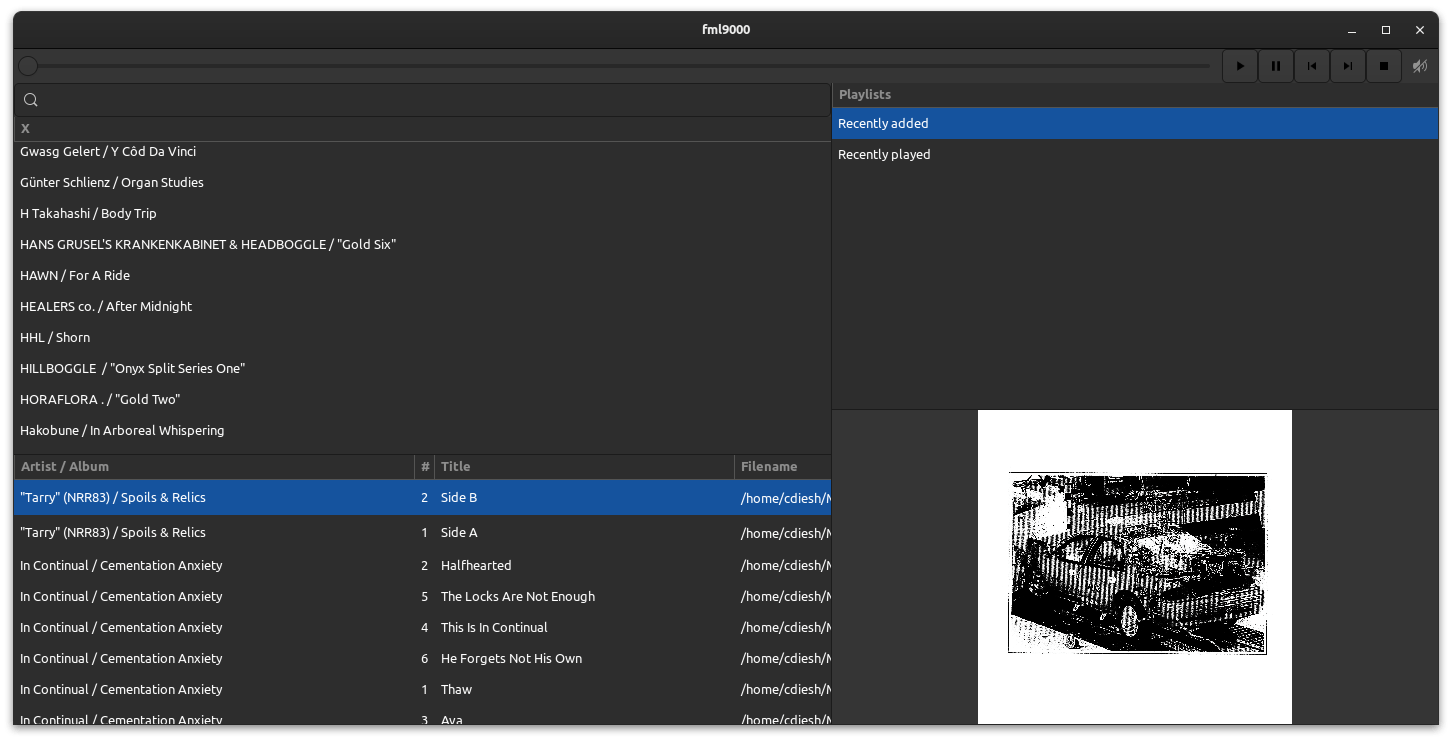I have started endeavoring to learn Rust. I did the rustlings exercises but I knew the concepts would fade rapidly from my brain without some practice. I have now started making a music player using Rust+GTK4.
I chose GTK4 to have a linux native GUI music player. Particularly, I have a
particular foobar2000 setup that I wanted to emulate. I have used foobar2000
under wine (windows emulator on linux) and it’s not terrible, but it has
background CPU consumption of about 15% idle and doesn’t feel quite right
sometimes. I have used a variety of other linux music players such as
quodlibet (GUI/GTK based) and cmus (command line) but they didn’t really
feel quite right.
Choosing a tech stack
I started by attempting with Relm4, which I may return to at some point, but
trying to juggle learning Relm4-style widgets, GTK, and rust all at once was a
bit much. I stepped to using gtk4-rs directly.
Create a “spreadsheet style” data grid of tracks with ColumnView
Then, I wanted to create a data grid showing to display e.g. a table with
artist, track, album, etc. I chose to use the GTK
ColumnView to drive this. I
stumbled around looking for example code, but there was none specifically for
the ColumnView. I also realized the ListView example from the gtk4-rs
examples with it’s factory function had similar needs that the ColumnView.
I found out that I basically needed to create a ListStore. I thought if I
could make my own GObject subclass, it would solve everything, but I had
trouble getting making this work (rust doesn’t have the concept of extending a
class for one thing, you implement various traits instead). Finally, I randomly
stumbled on this link using a BoxedAnyObject with a good example of storing
data in a ListStore
https://gtk-rs.org/gtk-rs-core/git/docs/glib/struct.BoxedAnyObject.html
The BoxedAnyObject is a GObject, so this was an good route to storing the
ListView items. There was no example code for connecting the ListStore with
the ColumnView, so I struggled for awhile before realizing that the ListView
example in the gtk4-rs codebase has similar concepts.
See [1] for minimal usage of ColumnView that I contributed to the gtk4-rs
repo!
Choosing an audio library
To actually play audio, I looked at a couple options. There was even one option
called GTK
MediaFile
which should to be able to play e.g. mp3s, making my job of making a media
player much simpler, but it produced an error
“GTK could not find a media module. Check your installation.”
which had very few references on the internet. I figured this could be difficult
to solve or point to issues I could face later on making minimal executables for
users.
So, next I tried out symphonia (https://github.com/pdeljanov/Symphonia/).
Symphonia requires a lot more code to work (~1000 lines so far, copying from the
symphonia-play example) but it has broad file format support, pure-rust audio
stack, etc. I got confused about how to package it into an easy-to-use system
though, having to create a symphonia player on a separate thread, so I looked
elsewhere…
Next I turned to rodio. This works well, and automatically plays on a separate
thread, but I found two issues 1) I have to initialize the rodio player in “fn
main” and not anywhere else, or it would just play a short blip of audio
(https://github.com/RustAudio/rodio/issues/381). Then, it turned out that the
rodio
Sink
instance (which you pass audio to) cannot stop and then play new song xref
(https://github.com/RustAudio/rodio/issues/315). To workaround, I replace it
with a new Sink.
This required me to learn about RefCell. I googled probably about 50 things
just grasping at straws for awhile, but then landed on the solution of putting
the Sink in a Rc<RefCell<Sink>>, then that allows me to pass it into my
callback that handles double clicking the songs in the ColumnView, and then I
borrow the RefCell mutably to replace it with a new Sink.
Reading audio metadata into an sqlite DB
I also wanted to have the option of reading and writing audio metadata.
Symphonia only reads metadata, so I found the lofty crate.
I also realized that reading tens of thousands of file’s metadata at each app
startup would be slow, so I endeavored to store that data in an sqlite
database. I found that music players like foobar2000 and 0xdeadbeef have
databases of track metadata also (Example folder on foobar2000 (1.x) for this
snap/foobar2000/433/foobar2000/profile/library/74E45640B1C695CC/meta-0001,
meta-0002, etc.)
I used the walkdir crate to walk a directory for files, lofty to read the
metadata, and then finally inserted the data into the sqlite db. I am still
working out the schema for the database but it provisionally associates data
with a primary key of filename.
Learning about reference counting and move semantics
Originally I queried the sqlite database and stored a Vec<Track>, where
Track is a struct with artist, album, song title, etc. I realized that this
causes issues passing this around to different functions, and storing them in
the BoxedAnyObject, (example thread discussing issue
https://stackoverflow.com/questions/42954008/how-to-pass-one-vec-to-multiple-functions-in-rust)
so I changed functions to accept slices of the Vec, and to make it a
Vec<Rc<Track>> instead of just Vec<Track> (another related thread
https://users.rust-lang.org/t/self-has-an-anonymous-lifetime-but-it-needs-to-satisfy-a-static-lifetime-requirement/58641/3).
Result
The current work is at https://github.com/cmdcolin/fml9000

Screenshot shows the current look and feel. Some stuff in the screenshot is mocked and not fully functional, but it has been a great learning experience thus far
Footnote 1: Creating a PR to the gtk4-rs repo to demonstrate example ColumnView usage
I created a PR (https://github.com/gtk-rs/gtk4-rs/pull/1111) to demonstrate
simple ColumnView usage. The code review that was given on the PR was
excellent. They explained how to simplify the code I submitted so that each grid
cell was very minimal (starting from a gtk::Box with a gtk::Label inside of
it, to just being a gtk::Inscription which is very fast). Big thanks to the
team for helping out with this!
After this hurdle was crossed, I felt much more comfortable in the GTK mindset, and I quickly fleshed out some more UI for the app